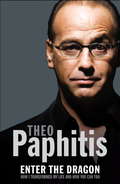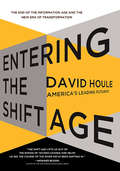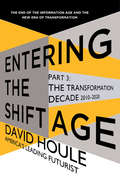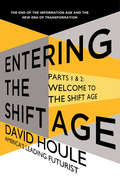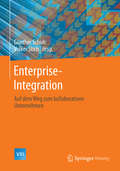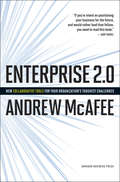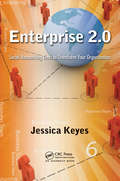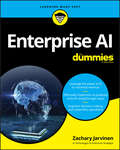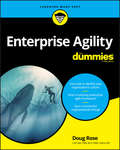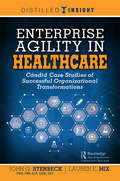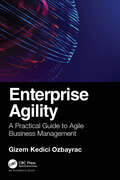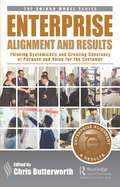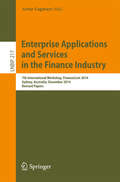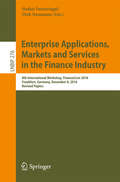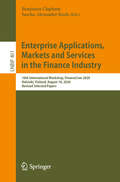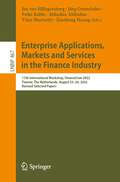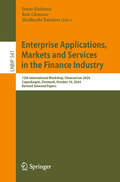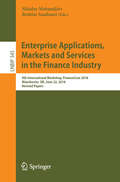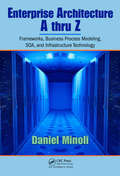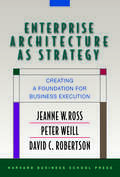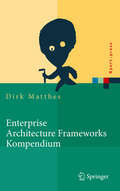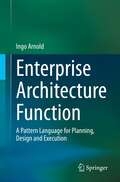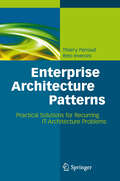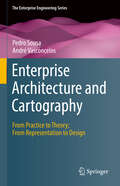- Table View
- List View
Enter the Dragon
by Theo PaphitisClassic rags-to-riches story by entrepreneur and Dragons' Den star Theo PaphitisTheo Paphitis is the outspoken and charismatic star of Dragons' Den who has turned round a string of household names, from Ryman to La Senza, in a high-profile business career that has brought him millions. Now, in his revealing and controversial memoir, he not only takes the reader behind the scenes on Dragons' Den, he explains how he made his fortune. He also provides a masterclass in business methods that will enable anyone who reads this book to learn so much about how they too can improve their business.In the book, Theo recalls how his family moved to England from Cyprus and how as a poor immigrant, he took whatever jobs he could, starting as a tea boy for Lloyd's. There he began to take the first steps on a career that would net him a fortune. He reveals the methods that took him to the top, and also provides some fascinating insight into the national game from his spell as chairman of Millwall FC. But, above all, this is a book that will provide all readers with the opportunity to learn from one of the nation's most successful businessmen and put his ideas into practice.
Entering the Shift Age
by David HouleThe Information Age? Think again. Change is everywhere: how we communicate, what we do for a living, the values we hold, the way we raise our children, even the way we access information. Thanks to a global economy, the force of the Internet, and the explosion of mobile technology, we have--almost imperceptibly--been ushered into a new era, the Shift Age, in which change happens so quickly that it's become the norm. Man-made developments--such as tools, machines, and technology--defined previous ages, but the Shift Age will be defined by our own power of choice. In Entering the Shift Age, leading futurist David Houle argues that we are going through a major collapse of legacy thinking, eroding many of the thought structures that have defined the last two hundred years of humanity. Houle identifies and explains the new forces that will shape our lives--including remote workplaces, the cloud, "24/7" culture, speed-of-light connectivity, creativity, and the influence of Millenials and Digital Natives--for the next twenty years. In this eye-opening book, Houle navigates this pivotal point in human history with clarity and anticipation, focusing on the power of human consciousness and the direct influence we can impart on everything from healthcare to media to education. According to Houle, we are more independent than ever before. We are in control. There's no "going back" to the way things were. Reality is changing ever faster, and ENTERING THE SHIFT AGE is your guide to keeping up.
Entering the Shift Age: The Transformation Decade 2010-2020
by David HouleWe are leaving the Information Age and transitioning into the Shift Age, a time of transformation and change that offers both great risk and incredible opportunity. In Entering the Shift Age, David Houle identifies and explains the dynamics and forces that have shaped our world and will continue to reshape our world for the next 20 years. He shows how the Shift Age means a world fully global yet focused on the individual, where the speed of change is so fast that change itself is the new norm. He also comments from the front lines of the Shift Age on issues and topics that affect our lives, from business and technology to environment, media and global culture. The Transformation Decade ebook examines the fundamental changes going on in 2010-2020 as we transition from the Information Age into the Shift Age, and what you need to be aware of as we navigate these important years.
Entering the Shift Age: Welcome to the Shift Age
by David HouleWe are leaving the Information Age and transitioning into the Shift Age, a time of transformation and change that offers both great risk and incredible opportunity. In Entering the Shift Age, David Houle identifies and explains the dynamics and forces that have shaped our world and will continue to reshape our world for the next 20 years. He shows how the Shift Age means a world fully global yet focused on the individual, where the speed of change is so fast that change itself is the new norm. He also comments from the front lines of the Shift Age on issues and topics that affect our lives, from business and technology to environment, media and global culture. The Welcome to the Shift Age ebook serves as an introduction to the concept of the Shift Age: how we got here, what is changing, and where we are going.
Enterprise -Integration: Auf dem Weg zum kollaborativen Unternehmen (VDI-Buch)
by Günther Schuh and Volker StichDas Buch beschreibt den betriebsorganisatorischen und logistischen Fortschritt , indem es das Thema „Enterprise-Integration“ als zukunftsweisenden Impuls aufnimmt. Ausgangshypothese ist, dass zukünftig die stete Weiterentwicklung bestehender Strukturen und Prozesse zur Sicherung der Wettbewerbsfähigkeit allein nicht mehr ausreichend wird. Vielmehr steht die Frage im Vordergrund, wie das Wertschöpfungssystem insgesamt gestaltet werden muss, um das Potenzial einzelner Technologien auch langfristig ausspielen zu können. Die Integrativität komplexer Wertschöpfungssysteme wird damit zu einem Gestaltungsparadigma betriebsorganisatorischer Forschung.Der Inhalt„Enterprise-Integration“ fügt Themen wie „Industrie 4.0“, „Cyber-physikalische Systeme“, „Ubiquitous Technologies“ und „Industrialisierung des Services“ zu einer Idee neuer Wertschöpfungssysteme zusammen. Dazu erarbeiten namhafte Autoren in einzelnen Sachbeiträgen Zukunftsvisionen, die in ein umfassendes Konzept eingeordnet werden.Die ZielgruppenSowohl Forscher als auch trendinteressierte Industrievertreter können diesem Buch wichtige Informationen zu den wirtschaftlichen Herausforderungen der Zukunft entnehmen.
Enterprise 2.0
by Andrew Mcafee"Web 2.0" is the portion of the Internet that's interactively produced by many people; it includes Wikipedia, Facebook, Twitter, Delicious, and prediction markets. In just a few years, Web 2.0 communities have demonstrated astonishing levels of innovation, knowledge accumulation, collaboration, and collective intelligence.Now, leading organizations are bringing the Web's novel tools and philosophies inside, creating Enterprise 2.0. In this book, Andrew McAfee shows how they're doing this, and why it's benefiting them. Enterprise 2.0 makes clear that the new technologies are good for much more than just socializing-when properly applied, they help businesses solve pressing problems, capture dispersed and fast-changing knowledge, highlight and leverage expertise, generate and refine ideas, and harness the wisdom of crowds.Most organizations, however, don't find it easy or natural to use these new tools initially. And executives see many possible pitfalls associated with them. Enterprise 2.0 explores these concerns, and shows how business leaders can overcome them.McAfee brings together case studies and examples with key concepts from economics, sociology, computer science, consumer psychology, and management studies and presents them all in a clear, accessible, and entertaining style. Enterprise 2.0 is a must-have resource for all C-suite executives seeking to make technology decisions that are simultaneously powerful, popular, and pragmatic.
Enterprise 2.0: Social Networking Tools to Transform Your Organization
by Jessica KeyesEnterprise 2.0 (E 2.0) has caught the collective imagination of executives who are innovating to radically change the face of business. E 2.0 takes full benefit of social networking, including blogs, discussion boards, mashups, and all that is sharable and combinable.Examining organizations and their social activities, Enterprise 2.0: Social N
Enterprise AI For Dummies
by Zachary JarvinenMaster the application of artificial intelligence in your enterprise with the book series trusted by millions In Enterprise AI For Dummies, author Zachary Jarvinen simplifies and explains to readers the complicated world of artificial intelligence for business. Using practical examples, concrete applications, and straightforward prose, the author breaks down the fundamental and advanced topics that form the core of business AI. Written for executives, managers, employees, consultants, and students with an interest in the business applications of artificial intelligence, Enterprise AI For Dummies demystifies the sometimes confusing topic of artificial intelligence. No longer will you lag behind your colleagues and friends when discussing the benefits of AI and business. The book includes discussions of AI applications, including : · Streamlining business operations · Improving decision making · Increasing automation · Maximizing revenue The For Dummies series makes topics understandable, and as such, this book is written in an easily understood style that’s perfect for anyone who seeks an introduction to a usually unforgiving topic.
Enterprise Agility For Dummies
by Doug RoseManage and improve your organization's agile transformation Adopting an enterprise agile framework is a radical organizational change, and this book will help you get there without ever breaking a sweat. In Enterprise Agility For Dummies, you'll discover how to successfully choose and implement the right framework based on your organization's own unique culture. Organizational culture is one of the most overlooked challenges when trying to make a change to enterprise agile, and there are lots of resources out there that claim to have the perfect, one-size-fits-all solution. Luckily, this book takes a neutral stance and covers popular organizational change management techniques that you can implement to suit to your unique needs. Packed with step-by-step instruction and complemented with real-world case studies, this book offers everything you need to know in order to embrace a more agile mindset. Understand the benefits of an agile approach Pick the best enterprise agile framework for your organization Create a successful enterprise change management plan Let Enterprise Agility For Dummies help you optimize your business processes, and watch your productivity soar.
Enterprise Agility at Komercni Banka
by Suraj Srinivasan Sarah Gulick Euvin NaidooIn 2017, Jan Juchelka, the new CEO of Komercni Banka, identified long term goals for the bank's progress. To do so, he began to shift the bank to an agile organizational structure. The case describes the bank's transformation, including the timeline for each department's move to agile, pitfalls, and the training and selection of managers. The case also describes the hiring of new employees in order to fill specialized IT roles, and the selection of McKinsey and Co. as advisors. The case asks what the next steps are for Komercni Banka, and what parts of the agile structure were still necessary to achieve.
Enterprise Agility in Healthcare: Candid Case Studies of Successful Organizational Transformations
by John G. Stenbeck Lauren E. MixEnterprise Agility in Healthcare explains why agility is vital to organizational survival. It details the critical variables that only executive leaders can address in a way that ensures success. It uses the experiences of two major healthcare organizations in order to frame the situational context surrounding the variables and then explains why and how the leaders in those organizations made choices that proved to be extraordinarily successful … in the real world! The common challenge shared by healthcare, aerospace, and information-centric industries of every type is the extraordinary complexity and uncertainty driven by the enormous number of individual, yet codependent factors, whether in humans and their cellular functioning, or vehicles and the interaction of materials and environment, requiring leaders and decision-makers at every level to connect, interact, and synthesize vital, fluctuating data, typically via technology-intermediated network structures with varying content and scale. The networks may be obvious, like the organizational structure, while others are more abstract or virtual, like social networks and ecosystems Despite healthcare’s amazing success in improving the quality and average lifespan of human beings, the maximum lifespan remains unchanged at no more than 125 years. Very few healthcare organizations live for much longer, with most disappearing before reaching one-third of that lifespan. How systems, people, and culture respond as organizational size changes is a challenge and also an opportunity in scaling for any information-centric industry. This book will use the actual, real-world experiences of two, very successful healthcare organizations to provide specific, actionable insights into the principles and practices that provoke success. Because scaling plays a determinative role in the successful design of everything from airplanes to skyscrapers, its impact on how effective and efficient an organization is remains a continuous challenge. Perhaps understanding scaling is of greater urgency due to the increasingly large and complex structures required for companies, institutions and governments to continuously evolve the complex adaptive systems they have become. This book focuses on organizational expansion in healthcare. By examining two organizations with similar, yet very different growth experiences, this book demonstrates very successful, very real outcomes while offering key insights into the principles and practices that drove them.
Enterprise Agility: A Practical Guide to Agile Business Management
by Gizem OzbayracDespite the astonishing technological developments in our times, it is surprising how little has changed in the way organizations are structured and managed. However, organizations are finally changing as they embark on agile transformations. Agility concepts emerged from the dynamics of project management and have evolved as they are being applied to organizational structure and operations. This phase of the agile evolution is known as enterprise agility. Filled with real-world scenarios and company case studies, Enterprise Agility: A Practical Guide to Agile Business Management covers the evolution of agility, including applied processes, lessons learned and realized outcomes. The book starts with the initial phase of the agile evolution, project agility and describes how waterfall project management is transformed into scrum, which can have positive effects on project timelines, scope and budget, as well as team motivation. The second phase of agility, organizational agility, is the evolution of the agile principles from temporary projects to permanent organizational structures. The book explains the main components of organizational agility, including structures, roles and ways of organizing work. It emphasizes the advantages of transitioning from traditional organizational management to agile. Finally, the latest phase, enterprise agility, transforms each function of the organization. The book acts as a guide and describes the change through the lens of each managerial domain (sales, marketing, HR, finance etc.) and by presenting the positive impact generated on the company’s overall performance based on case studies. The last chapter illustrates the enablers of this transformation and how they can help the change to be internalized so that the enterprises realize improvements. The book is based on the author’s over 15 years of experience of supporting more than 25 companies in varied sectors on their transformational journey, with the last 5 years concentrating on agility. By combining business management trends and principles of agile business development, it shows managers how to lead the transformation to enterprise agility by following the path from project agility to full enterprise agility.
Enterprise Alignment and Results: Thinking Systemically and Creating Constancy of Purpose and Value for the Customer (The Shingo Model Series)
by Chris ButterworthTo succeed, an organization must cultivate management systems that effectively align their work and behaviors with principles and direction. These systems should be simple, comprehensible, actionable, and standardized. Establishing alignment in every value stream of an organization will ultimately create value for their customers and produce the desired results. This alignment stems from an understanding of why an organization exists, where it is going, and how it will get there. Enterprise Alignment and Results guides readers to their goal of enterprise-wide alignment by providing a deeper look at the Shingo Model. This book builds upon the previous books in the Shingo Model Series by continuing to define ideal behaviors and the systems that drive them and increasing understanding of fundamental beliefs and how to use behavioral benchmarks. As readers examine the principles of "Create Constancy of Purpose," "Think Systemically," and "Create Value for the Customer," they will gain a deeper knowledge of the relationship between behaviors, systems, and principles. This knowledge will foster an understanding of how to create alignment within their organizations, thereby increasing the consistency of delivering ideal results.
Enterprise Applications and Services in the Finance Industry
by Artur LugmayrThis book constitutes the proceedings of the 7th International Workshop on Enterprise Applications and Services in the Finance Industry, FinanceCom 2014, held in Sydney, Australia, on December 12, 2014. The workshop spans multiple disciplines, including technical, service, economic, sociological, and behavioral sciences. It reflects on technologically enabled opportunities, implications, and changes due to the introduction of new business models or regulations related to the financial services industry and the financial markets. The nine papers presented were carefully reviewed and selected from numerous submissions.
Enterprise Applications, Markets and Services in the Finance Industry
by Stefan Feuerriegel Dirk NeumannThis book constitutes revised selected papers from the 8th International Workshop on Enterprise Applications, Markets and Services in the Finance Industry, FinanceCom 2016, held in Frankfurt, Germany, in December 2016. The 2016 workshop especially focused on "The Analytics Revolution in Finance" and brought together leading academics from a broad range of disciplines, including computer science, business studies, media technology and behavioral science, to discuss recent advances in their respective fields. The 9 papers presented in this volume were carefully reviewed and selected from 13 submissions.
Enterprise Applications, Markets and Services in the Finance Industry: 10th International Workshop, FinanceCom 2020, Helsinki, Finland, August 18, 2020, Revised Selected Papers (Lecture Notes in Business Information Processing #401)
by Benjamin Clapham Jascha-Alexander KochThis book constitutes the revised selected papers from the 10th International Workshop on Enterprise Applications, Markets and Services in the Finance Industry, FinanceCom 2020, held in Helsinki, Finland, in August 2020. Due to the COVID-19 pandemic the conference took place virtually.The 6 full papers presented together with 1 extended abstract in this volume were carefully reviewed and selected from a total of 14 submissions to the workshop.They are grouped in topical sections named Machine Learning Applications in Trading and Financial Markets, Fraud Detection and Information Generation in Finance, and Alternative Trading and Investment Offerings by FinTechs.The workshop spans multiple disciplines, including analytical, technical, service, economic, sociological and behavioral sciences.
Enterprise Applications, Markets and Services in the Finance Industry: 11th International Workshop, FinanceCom 2022, Twente, The Netherlands, August 23–24, 2022, Revised Selected Papers (Lecture Notes in Business Information Processing #467)
by Jos Van Hillegersberg Jörg Osterrieder Fethi Rabhi Abhishta Abhishta Vijay Marisetty Xiaohong HuangThis book constitutes revised selected papers from the 11th International Workshop on Enterprise Applications, Markets and Services in the Finance Industry, FinanceCom 2022, held in Twente, The Netherlands, in August 2022.The 8 full papers presented in this volume were carefully reviewed and selected from a total of 25 submissions. They deal with the adoption of innovative technologies in the financial services industry. The conference features four main themes: networks and business models, financial markets, IT and implementations, and new emerging digital and virtual financial markets.
Enterprise Applications, Markets and Services in the Finance Industry: 12th International Workshop, FinanceCom 2024, Copenhagen, Denmark, October 10, 2024, Revised Selected Papers (Lecture Notes in Business Information Processing #541)
by Jonas Hedman Rob Gleasure Madhushi BandaraThis book constitutes revised selected papers from the 12th International Workshop on Enterprise Applications, Markets and Services in the Finance Industry, FinanceCom 2024, held in Copenhagen, Denmark, on October 10, 2024. The 5 full papers presented in this volume were carefully reviewed and selected from a total of 8 submissions. They deal with the adoption of innovative technologies in the financial services industry. In addition, two invited papers which are closely related with the conference topics were also included after a thorough review. The conference features five main themes: networks and business models, financial markets, IT and implementations, new emerging digital and virtual financial markets, and AI revolution in finance.
Enterprise Applications, Markets and Services in the Finance Industry: 9th International Workshop, FinanceCom 2018, Manchester, UK, June 22, 2018, Revised Papers (Lecture Notes in Business Information Processing #345)
by Nikolay Mehandjiev Brahim SaadouniThis book constitutes revised selected papers from the 9th International Workshop on Enterprise Applications, Markets and Services in the Finance Industry, FinanceCom 2018, held in Manchester, UK, in June 2018. The 11 papers presented in this volume were carefully reviewed and selected from 18 submissions. They were organized in topical sections named: financial innovation; market data analytics; and semantic modelling.
Enterprise Architecture A to Z: Frameworks, Business Process Modeling, SOA, and Infrastructure Technology
by Daniel MinoliEnterprise Architecture A to Z examines cost-saving trends in architecture planning, administration, and management. The text begins by evaluating the role of Enterprise Architecture planning and Service-Oriented Architecture (SOA) modeling. It provides an extensive review of the most widely-deployed architecture framework models, including The Open Group Architecture and Zachman Architectural Frameworks, as well as formal architecture standards. The first part of the text focuses on the upper layers of the architecture framework, while the second part focuses on the technology architecture. Additional coverage discusses Ethernet, WAN, Internet communication technologies, broadband, and chargeback models.
Enterprise Architecture As Strategy
by David Robertson Jeanne W. Ross Peter WeillDoes it seem you've formulated a rock-solid strategy, yet your firm still can't get ahead? If so, construct a solid foundation for business execution-an IT infrastructure and digitized business processes to automate your company's core capabilities. In Enterprise Architecture as Strategy: Creating a Foundation for Business Execution, authors Jeanne W. Ross, Peter Weill, and David C. Robertson show you how.The key? Make tough decisions about which processes you must execute well, then implement the IT systems needed to digitize those processes. Citing numerous companies worldwide, the authors show how constructing the right enterprise architecture enhances profitability and time to market, improves strategy execution, and even lowers IT costs. Though clear, engaging explanation, they demonstrate how to define your operating model-your vision of how your firm will survive and grow-and implement it through your enterprise architecture. Their counterintuitive but vital message: when it comes to executing your strategy, your enterprise architecture may matter far more than your strategy itself.
Enterprise Architecture Frameworks Kompendium
by Dirk MatthesIn dem Band werden 50 Enterprise Architecture Frameworks (EAF) ausführlich behandelt und 45 weitere hinsichtlich ihrer Intention kurz und prägnant dargestellt. Die detaillierten Beschreibungen erlauben durch ein einheitliches Raster den Vergleich unterschiedlicher EAF. Sie enthalten Informationen zum Entwickler, zu Versionen, zur Marktrelevanz, zu Abhängigkeiten, Verfügbarkeit, unterstützenden Tools sowie Anschaffungskosten. Die Unterstützungsvielfalt, die Frameworks bieten, demonstriert der Autor anhand eines Anwendungsszenarios.
Enterprise Architecture Function: A Pattern Language for Planning, Design and Execution
by Ingo ArnoldThis book provides a method to plan, develop, validate, or evolve the design of an enterprise architecture function so that it fully meets the organization’s needs. The reader will benefit from this book in two ways. First, it provides a structured overview and orientation to the subject of architecture from an architecture function perspective. Second, it guides through the process of planning, building, and operating your own architecture organization based on a generic architecture function blueprint presented in the form of a pattern language offering a structured means for navigating, contextualizing, combining, and composing the architecture function patterns. The book is structured in six chapters. Chapter 1 “Introduction” explains the starting position and objectives of the book and introduces key concepts that will be explained further in subsequent chapters. Chapter 2 “Architecture Function Pattern Language” introduces the concepts of pattern, pattern catalogue, pattern topology, and ontology and explains how these concepts are combined to form a pattern language for planning, designing, and operating an architecture function. Next, Chapter 3 “Architecture Function – Context“ introduces concepts that are crucial for understanding the challenges that an architecture function faces and presents a generic schema for the business organizations and value chain. Chapter 4 “Architecture Function – Challenge” looks at an architecture function from a black box perspective and outlines the expectations and requirements that companies place on architecture organizations. It discusses the building blocks of an architecture function, the services it provides along the enterprise value chain, and the quality attributes that enterprises expect from their functions. Chapter 5 “Architecture Function – Constitution” then shifts from a black-box perspective to a white-box perspective and outlines the generic design of an architecture function in order to realize functional and quality-related requirements. Chapter 6 “Pattern Catalogue“ eventually introduces the pattern catalogue with a total of 48 architecture function patterns. These patterns suggest designs for collaboration between the architecture function and enterprise organizations, for the elaboration and development of enterprise services along the enterprise value chain, or for aligning architecture governance with enterprise governance. The book is intended for a broad readership, including enterprise, domain, and solution architects, lecturers and students, and anyone else interested in understanding the value proposition, responsibilities, outcomes, methods, and practices of architecture functions. It introduces the basic concepts and theories needed to understand the pattern language presented and the patterns it summarizes.
Enterprise Architecture Patterns: Practical Solutions for Recurring IT-Architecture Problems
by Reto Inversini Thierry PerroudEvery enterprise architect faces similar problems when designing and governing the enterprise architecture of a medium to large enterprise. Design patterns are a well-established concept in software engineering, used to define universally applicable solution schemes. By applying this approach to enterprise architectures, recurring problems in the design and implementation of enterprise architectures can be solved over all layers, from the business layer to the application and data layer down to the technology layer. Inversini and Perroud describe patterns at the level of enterprise architecture, which they refer to as Enterprise Architecture Patterns. These patterns are motivated by recurring problems originating from both the business and the underlying application, or from data and technology architectures of an enterprise such as identity and access management or integration needs. The Enterprise Architecture Patterns help in planning the technological and organizational landscape of an enterprise and its information technology, and are easily embedded into frameworks such as TOGAF, Zachman or FEA. This book is aimed at enterprise architects, software architects, project leaders, business consultants and everyone concerned with questions of IT and enterprise architecture and provides them with a comprehensive catalogue of ready-to-use patterns as well as an extensive theoretical framework to define their own new patterns.
Enterprise Architecture and Cartography: From Practice to Theory; From Representation to Design (The Enterprise Engineering Series)
by Pedro Sousa André VasconcelosThis textbook provides guidance to both students and practitioners of enterprise architecture (EA) on how to develop and maintain enterprise models. Rather than providing yet another list of EA notations and frameworks from A to Z, it focuses on methods to perform such tasks. The problem of EA maintenance, named Enterprise Cartography, is an important aspect addressed in this book because EA is a never ending challenge that increases as the organization transformations pace also increases. The long time perspective also entails the evolution of architectural frameworks and notations, something that does not occur when developing new models. Thus, a catalogue of patterns, principles and methods is presented to develop and maintain EA models and views. After a general introduction to the book in chapter 1, chapter 2 presents basic concepts for EA modeling. Chapter 3 further details the set of EA concepts needed to present the patterns, and principles, which are subsequently introduced in chapter 4. Next, chapter 5 describes enterprise cartography concepts and principles. The remaining book then turns to techniques and methodologies. In chapter 6 an EA development method is summarized. In chapter 7 an enterprise strategy design approach is proposed, while in chapter 8 a business process design methodology is described. Chapters 9 and 10 focus on information architecture and information systems architecture design approaches, including information systems architecture planning and application portfolio management. Eventually, chapter 11 describes a method for enterprise cartography (EC) design. Last not least, several case studies on EA and EC are proposed in the last chapter.
